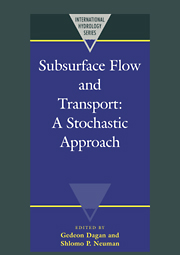Book contents
- Frontmatter
- Contents
- List of contributors
- Preface
- Acknowledgments
- I INTRODUCTION
- II SUBSURFACE CHARACTERIZATION AND PARAMETER ESTIMATION
- 1 Characterization of geological heterogeneity
- 2 Application of geostatistics in subsurface hydrology
- 3 Formulations and computational issues of the inversion of random fields
- III FLOW MODELING AND AQUIFER MANAGEMENT
- IV TRANSPORT IN HETEROGENEOUS AQUIFERS
- V FRACTURED ROCKS AND UNSATURATED SOILS
- VI A VIEW TO THE FUTURE
1 - Characterization of geological heterogeneity
Published online by Cambridge University Press: 04 December 2009
- Frontmatter
- Contents
- List of contributors
- Preface
- Acknowledgments
- I INTRODUCTION
- II SUBSURFACE CHARACTERIZATION AND PARAMETER ESTIMATION
- 1 Characterization of geological heterogeneity
- 2 Application of geostatistics in subsurface hydrology
- 3 Formulations and computational issues of the inversion of random fields
- III FLOW MODELING AND AQUIFER MANAGEMENT
- IV TRANSPORT IN HETEROGENEOUS AQUIFERS
- V FRACTURED ROCKS AND UNSATURATED SOILS
- VI A VIEW TO THE FUTURE
Summary
Longitudinal distortion attributable to macroscopic structure can be determined on a scale consistent with the variance of hydraulic conductivity.
(Kovacs, 1983)INTRODUCTION
Heterogeneity of porous media has been a troublesome topic from the very beginning of groundwater hydrology as a quantitative science. Darcy (1856) recognized the necessity to quantify flow through porous media using a macroscopic, rather than a microscopic, viewpoint; he defined a flux based on an average linear flow path through a representative volume of porous media. Meinzer (1932) called heterogeneity the ‘most formidable difficulty’ in quantifying aquifer parameters. Shortly after this, Theis (1935) offered a solution to the heterogeneity problem by developing a way of calculating effective aquifer parameters. He demonstrated that by measuring the drawdown of water levels in response to pumping, it is possible to use an analytical solution to calculate effective aquifer parameters for average transmission and storage characteristics. Theis' method in essence replaces the heterogeneous aquifer with an equivalent homogeneous porous medium.
Theis' technique for dealing with heterogeneity allowed groundwater hydrologists to ignore geological heterogeneity for approximately 40 years. Then, Freeze (1975) called attention to the effect of uncertainty in hydraulic conductivity on the head distribution computed using groundwater models. About the same time, researchers were beginning to attempt to use the advection–dispersion equation to describe the transport of contaminant plumes in groundwater (Bredehoeft & Pinder, 1973; Pinder, 1973), and they were confronted with the problem of quantifying the dispersion coefficient. Slichter (1905) had earlier recognized that the spreading he observed in tracer experiments could not be due solely to the effects of molecular diffusion.
- Type
- Chapter
- Information
- Subsurface Flow and TransportA Stochastic Approach, pp. 23 - 43Publisher: Cambridge University PressPrint publication year: 1997
- 46
- Cited by



